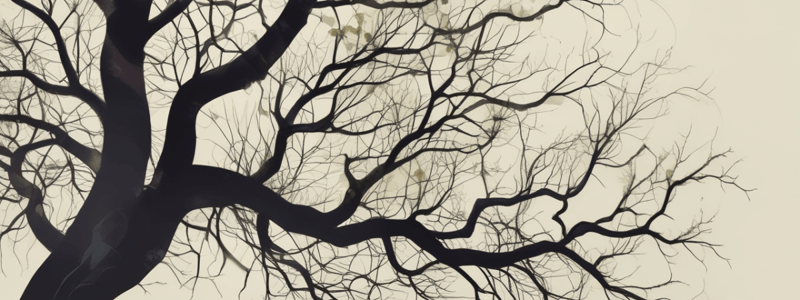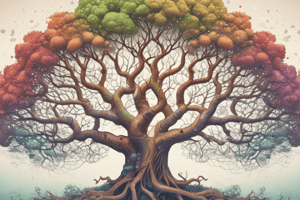Podcast
Questions and Answers
What is the study of the interactions between organisms and their environment?
What is the study of the interactions between organisms and their environment?
- Zoology
- Ecology (correct)
- Microbiology
- Botany
What is the basic unit of life?
What is the basic unit of life?
- Organism
- Tissue
- Organ
- Cell (correct)
What is the process by which plants produce energy?
What is the process by which plants produce energy?
- Respiration
- Fermentation
- Metabolism
- Photosynthesis (correct)
What is the molecule that contains genetic information?
What is the molecule that contains genetic information?
What is the process by which individuals with favorable traits are more likely to survive and reproduce?
What is the process by which individuals with favorable traits are more likely to survive and reproduce?
What is the type of evolution that refers to small-scale changes within a population?
What is the type of evolution that refers to small-scale changes within a population?
What is the community of living and non-living things in an environment?
What is the community of living and non-living things in an environment?
What is the type of factor that includes light, temperature, water, and soil?
What is the type of factor that includes light, temperature, water, and soil?
Study Notes
Branches of Biology
- Botany: study of plants
- Zoology: study of animals
- Microbiology: study of microorganisms
- Ecology: study of interactions between organisms and their environment
- Genetics: study of heredity and variation
- Biochemistry: study of chemical processes in living organisms
- Biophysics: study of physical principles underlying biological processes
Cell Biology
- Cells are the basic units of life
- Cell structure:
- Plasma membrane: outer layer of cell
- Cytoplasm: jelly-like substance inside cell
- Nucleus: contains genetic material (DNA)
- Mitochondria: generate energy for cell
- Cell functions:
- Metabolism: chemical reactions that occur within cell
- Photosynthesis: process by which plants produce energy
- Cell division: process by which cells reproduce
Genetics
- Heredity: passing of traits from parents to offspring
- DNA (deoxyribonucleic acid):
- Double helix structure
- Contains genetic information
- Genes: segments of DNA that code for specific traits
- Traits:
- Dominant: trait that will be expressed if present
- Recessive: trait that will not be expressed if dominant trait is present
- Inheritance patterns:
- Mendelian inheritance: follows predictable patterns
- Non-Mendelian inheritance: does not follow predictable patterns
Evolution
- Theory of evolution: species change over time through natural selection
- Natural selection:
- Process by which individuals with favorable traits are more likely to survive and reproduce
- Leads to adaptation and speciation
- Types of evolution:
- Microevolution: small-scale changes within a population
- Macroevolution: large-scale changes between species
- Evidence for evolution:
- Fossil record
- Comparative anatomy
- Molecular biology
Ecosystems
- Ecosystem: community of living and non-living things in an environment
- Biotic factors:
- Producers: organisms that make their own food (plants)
- Consumers: organisms that obtain energy by consuming other organisms
- Decomposers: organisms that break down dead organic matter
- Abiotic factors:
- Light
- Temperature
- Water
- Soil
- Energy flow:
- Producers convert sunlight into energy
- Energy is passed from one organism to another through food chains and webs
Branches of Biology
- Botany: Focuses on the study of plants and their processes.
- Zoology: Investigates animal life and behavior.
- Microbiology: Examines microorganisms, including bacteria and viruses.
- Ecology: Studies how organisms interact with each other and their environments.
- Genetics: Explores heredity and variations among organisms.
- Biochemistry: Analyzes chemical processes and substances within living beings.
- Biophysics: Applies principles of physics to understand biological functions.
Cell Biology
- Basic Unit of Life: Cells are fundamental structures that make up all living organisms.
- Cell Structure:
- Plasma Membrane: Encloses the cell, providing protection and structural support.
- Cytoplasm: Gel-like fluid where cellular components are suspended.
- Nucleus: Houses DNA, the hereditary material.
- Mitochondria: Energy-producing organelles, termed the "powerhouses" of the cell.
- Cell Functions:
- Metabolism: Encompasses all biochemical reactions essential for maintaining life.
- Photosynthesis: Converts light energy into chemical energy in plants.
- Cell Division: Mechanism through which cells replicate to support growth and repair.
Genetics
- Heredity: The process by which traits are transmitted from parents to offspring.
- DNA Structure: Composed of two intertwined strands forming a double helix that contains genetic blueprints.
- Genes: Specific sequences within DNA that dictate particular traits or characteristics.
- Traits:
- Dominant Traits: Will manifest in the phenotype if present.
- Recessive Traits: Only expressed when paired with another recessive gene.
- Inheritance Patterns:
- Mendelian Inheritance: Governed by predictable ratios and genetic segregation.
- Non-Mendelian Inheritance: Characterized by more complex patterns, including incomplete dominance and polygenic traits.
Evolution
- Theory of Evolution: Proposes that species evolve over time through processes like natural selection.
- Natural Selection:
- A mechanism where individuals with advantageous traits have higher survival and reproduction rates.
- Drives adaptations and contributes to the creation of new species (speciation).
- Types of Evolution:
- Microevolution: Subtle changes occurring within a population over generations.
- Macroevolution: Extensive alterations granting rise to new species.
- Evidence for Evolution:
- Fossil Record: Provides historical documentation of organism transitions.
- Comparative Anatomy: Studies structural similarities across different species.
- Molecular Biology: Examines genetic material, revealing shared ancestry among diverse organisms.
Ecosystems
- Ecosystem Definition: Comprises living (biotic) and non-living (abiotic) components interacting in a specific environment.
- Biotic Factors:
- Producers: Autotrophs (primarily plants) that synthesize their own food using photosynthesis.
- Consumers: Heterotrophs that derive energy by consuming other organisms.
- Decomposers: Organisms, like fungi and bacteria, that recycle nutrients by breaking down dead matter.
- Abiotic Factors:
- Light: Essential for photosynthesis.
- Temperature: Influences metabolic rates of organisms.
- Water: Vital for all forms of life.
- Soil: Provides nutrients and habitat for organisms.
- Energy Flow:
- Initiated by producers capturing sunlight and translating it to energy, which is then transferred through food chains and webs to consumers.
Studying That Suits You
Use AI to generate personalized quizzes and flashcards to suit your learning preferences.
Description
This quiz covers the different branches of biology, including botany, zoology, and microbiology, as well as the structure and functions of cells, the basic units of life.




